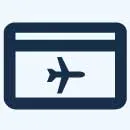The hidden costs that sometimes come with your travel money can sour a perfectly sweet holiday. The trick is to read the fine print, understand your options, and make the right choices. You can start saving for your next trip by being careful about what you’re paying for. This guide breaks down the hidden costs and charges of taking your travel card overseas and how to avoid them.
The major travel money costs and how you can avoid them
- Costs for making purchases overseas
- Costs for withdrawing cash overseas
- Common fees with prepaid travel cards
- Common fees with travel credit cards
 Fees for purchasing overseas
Fees for purchasing overseas
Currency conversion fees
Currency conversion fees are charged when you use a credit card or debit card and you spend in a currency that is foreign to the default currency on your card (eg. if you use your Australian credit or debit card abroad). Usually it's about 3%, which means you could get charged $60 on top of your $2,000 hotel stay, and bleed hundreds of dollars on your total holiday expenditure.
- How to avoid it?
Steer clear of this fee on your credit and debit cards by seeking out cards that waive currency conversion fees. Check out our list of credit cards with no foreign currency fees and debit cards with low foreign transaction fees. You can also avoid this fee on your travel card by preloading sufficient amounts of the particular foreign currency you intend to spend.
Poor exchange rates
Aside from currency fluctuations that could impact your travel budget, where you exchange your money is important too. Exchange rates at the airport exchange desks or foreign money changers are usually a worse deal for you, because they have a captive market and you don't have the opportunity to shop around.
- How to avoid it?
We recommend you avoid exchanging your money at airports or with random foreign money changers. Pre-buy your foreign currency in Australia after doing some research to lock in the best rate. If you’re concerned about currency fluctuations, consider a travel card that’ll lock in the exchange rate when you load funds on the card. While this will protect you against negative currency movements, it could also restrict you from benefit from exchange rate changes that could boost your balance.
Back to top Fees for withdrawing cash overseas
Fees for withdrawing cash overseas
ATM withdrawal fees
You could find yourself paying this fee twice for each overseas ATM withdrawal you make – once to your card provider, and once to the foreign ATM owner. This is because the ATM owner in that country charges a fee, as does your card provider, and both their fees could add up to $10 per transaction.
- How to avoid it?
Spare yourself this meaningless expense by only withdrawing funds from your card provider’s international ATM partners (after making sure it’s free for you), or by withdrawing larger sums per transaction and minimising your ATM visits.
Some major Australian banks have a network of ‘global alliance partners’ that let Australians withdraw money from their ATMs abroad for free. For instance, the Westpac Global ATM alliance partners with banks including Barclays Bank, Deutsche Bank, Bank of America and DBS to form a robust international ATM network that could serve you well, depending on where you’re going.
Or, you could also opt for a travel-friendly card with no overseas ATM withdrawal fees.
"I did a heap of research to figure out the best option! We got the Wise travel card for Fiji and it was so easy to use and transfer money. It gives daily exchange rates on the app. You also get two free ATM withdrawals and when we got home, we just transferred what we didn't use back to our normal account. So easy!."
Cash advance fees
This is a fee that credit card companies charge for essentially loaning you cash. You incur a cash advance fee each time you make an ATM withdrawal using your credit card, which is aside from the interest charged.
- How to avoid it?
Cash advance fees are usually accompanied by hefty interests on the transaction amount that accrue from the moment you make that ATM withdrawal. We’d encourage you to avoid both of those fees by not making cash withdrawals on your credit card. Instead, make sure to pack a prepaid travel card or debit card that you can use for overseas withdrawals.
Back to top Fees using prepaid travel money cards
Fees using prepaid travel money cards
Travel money loading and reloading fees
When you first set up your travel money card, you might be charged an initial loading fee for transferring your funds into foreign currencies on the card. You might also be charged a reloading fee each time you need to top up your card. You might find that you are shedding tens of dollars each time you load your travel card up.
- How to avoid it?
Some travel cards charge a reload fee as high as $15 for each reload. Depending on your card, reloading a larger amount each time to minimise your number of reloads may help you avoid or lower this cost. Sometimes, however, the card provider might charge a percentage fee of the reload amount whenever it exceeds their fixed reload fee, whichever is higher. This makes it impossible to avoid the reloading fee, in which case you should consider shopping for another travel card with low or $0 loading and reloading fees.
Card issue fees/purchase fees
If you have a travel money card, you might be charged a purchase fee when you first order the card.
- How to avoid it?
If your travel card charges an issue or purchase fee, the provider may compensate by waiving other fees. For example, a card that charges an initial fee might not charge a reload fee, while a card that waives the issue fee might charge reload fees for each subsequent transaction. If the amount you’ll pay on reloads outweighs the purchase fee, then getting a card with a purchase fee might be worth it. If not, start comparing cards that you can pick up for free.
Account inactivity fees
These apply to some travel money cards, where your card provider might impose a monthly fee for maintaining your account following a period of inactivity, usually 12 months.
- How to avoid it?
If you wish to keep your card and account active, a possible workaround might be to make a small transfer at the end of 12 months. If there’s a reloading fee for this transfer that outweighs the amount saved on the inactivity fees however, you might want to consider closing the account. The last thing you want is for your remaining funds to be slowly devoured by the monthly inactivity fee worm. Read our guide on how to claim your remaining travel card funds.
Account closure fees
When you close your travel money card, you may find that you’re charged an account closure fee.
- How to avoid it?
If you want to close your account after your holiday, the only way you can avoid this cost is by choosing a card that doesn’t charge a closure fee. When you’re comparing your options, check our review pages and the product disclosure statement of the card to confirm whether a closure fee applies.
Back to top Fees for using travel credit cards
Fees for using travel credit cards
Annual fees
Similarly, there are many credit cards out there with zero annual fees or enticing annual fee waivers. Be sure to check if the annual fee is waived just for the first year or for life. Cards designed for overseas use can also come at a price, so make sure that the annual fee doesn’t outweigh any potential benefits.
- How to avoid it?
If you’re only planning to use your credit card for your holiday, consider a credit card with no annual fee. Sometimes, the price for having low or zero currency conversion fees and international ATM withdrawal fees can be offset by a high annual fee. Before committing to a card, do your research and make some projected calculations based on the amounts you will likely spend and save. Make sure that the savings you will reap are greater than the fees charged for using the card.
Interest charges
When you use your credit card, not only will you have to repay the purchase amount, you may also have to pay interest. Interests on purchases are less menacing when your bank gives you an interest-free grace period, but be sure to pay off your account punctually or you could find yourself with a huge interest debt down the road.
- How to avoid it?
You could get a travel-friendly 0% interest credit card, or make sure you pay your balance in full to take advantage of the interest-free days offer. You could also prepay on your account, which would then let you make cash withdrawals using the credit card without incurring interest. While you’re travelling overseas, consider using a prepaid travel card or debit card for everyday purchases and leaving your credit card for emergencies or large purchases to avoid interest.
Merchant fees
The overseas merchant adds a surcharge to your transaction just because you’re using a foreign-issued credit card. Also, if you agree to pay in Australian dollars while overseas, you’re agreeing to the dynamic currency conversion rate which incorporates a fee to the merchant, on top of a less favourable exchange rate and the currency conversion fee which your card company may also charge.
- How to avoid it?
Always be vigilant about checking your receipt or your bill before paying. Ask when in doubt about any item, and always say “no” when invited to pay in your home currency.
Back to topFinder survey: How do Australians prefer to pay when travelling overseas?
Response | |
|---|---|
| Cash/local currency | 30.68% |
| Credit card | 22.51% |
| Debit card | 21.81% |
| Prepaid travel money card | 16.83% |
| Other | 6.57% |
| Travellers cheques | 1.59% |
Other travel money tips and guides
- How to claim money left on your travel money card
- What to do when your travel card is lost or stolen
- Options if your prepaid travel card doesn't support the local currency
Ask a question
More guides on Finder
-
The cost of a pint of beer around the world
Use finder's interactive world map to learn about variations in beer prices globally. Find out where in the world you'd pay a whopping $15.10 for a pint.
-
Travel money tips for teenagers
Discover the travel money options available for young people and how to prepare for a trip overseas.
-
The best travel money cards for Australian travellers
Find out which travel cards are the best to use in the 10 most popular holiday destinations for Aussie travellers.
-
Currency Exchange Australia
Use this guide to understand foreign currency exchange and discover how to get the best deal.
-
Travel money guide: Singapore
Compare how you can take your money to Singapore using a prepaid travel card, debit or credit card.
-
Travel Money Guide: Indonesia
All the information you need to take the right travel money to Indonesia so you can save some dollars.
-
Travel Money Guide: UK
Travelling to the UK soon? Find and compare the best travel money options to take with you.
-
Travel Money Guide: Thailand
Compare the travel products which are cheaper to use to withdraw and spend baht in Thailand.
-
Travel Money Guide: USA
The USA has a culture of credit, and it’s a society of card payments, read our travel money guide to find out which travel products to use and which to avoid using in the USA.
